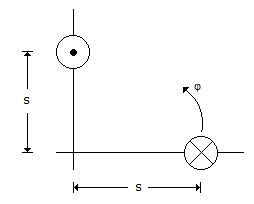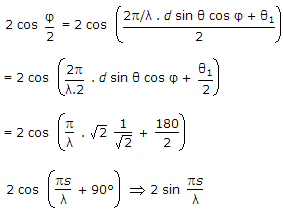Electronics and Communication Engineering - Electromagnetic Field Theory
Exercise : Electromagnetic Field Theory - Section 1
- Electromagnetic Field Theory - Section 1
- Electromagnetic Field Theory - Section 2
- Electromagnetic Field Theory - Section 3
- Electromagnetic Field Theory - Section 4
- Electromagnetic Field Theory - Section 5
- Electromagnetic Field Theory - Section 6
- Electromagnetic Field Theory - Section 7
- Electromagnetic Field Theory - Section 8
- Electromagnetic Field Theory - Section 9
- Electromagnetic Field Theory - Section 10
- Electromagnetic Field Theory - Section 11
- Electromagnetic Field Theory - Section 12
- Electromagnetic Field Theory - Section 13
41.
A transmission line is feeding 1 watt of power to a horn antenna having a gain of 10 dB. The antenna is matched to the transmission line. The total power radiated by the horn antenna into the free space is
Answer: Option
Explanation:
 = 101
= 101  Pr = 10 watt.
Pr = 10 watt.
42.
A parallel polarized wave is incident from air into paraffin having relative permittivity 3, the value of its Brewster angle is
Answer: Option
Explanation:
Brewster angle θ = tan-1  .
.
43.
In a conductor which of the following relations hold good?
Answer: Option
Explanation:
Inside a conductor free charge is zero, hence, ∇ x D = 0.
44.
The radiation resistance of a λ/16 wire dipole in free space will be nearly
Answer: Option
Explanation:
Rr = 80p2 .
.
45.
Two identical antennas are placed in the θ = p/2 plane as shown in the figure. The elements have equal amplitude excitation with 180° polarity difference, operating of the far-zone resultant electric field strength normalized with that of a single element, both computed for φ = 0, is


Answer: Option
Explanation:
Normalised array factor = n cos 

where φ is the phase difference.
 φ = (βd sin θ cos φ + θ1)
φ = (βd sin θ cos φ + θ1)
and θ = 90°, φ = 45°

Quick links
Quantitative Aptitude
Verbal (English)
Reasoning
Programming
Interview
Placement Papers



